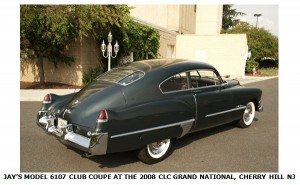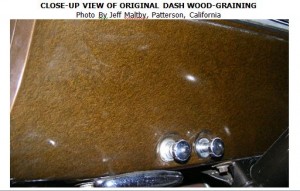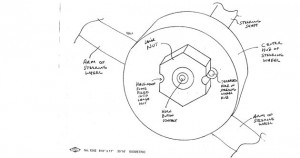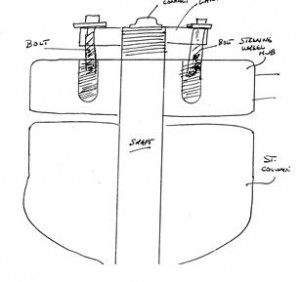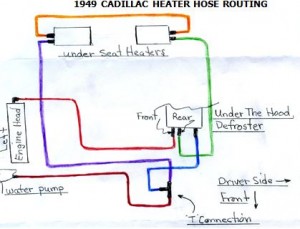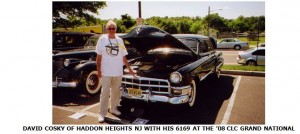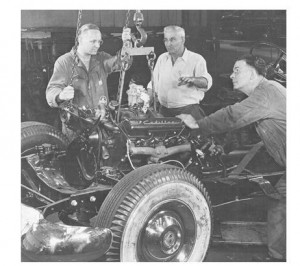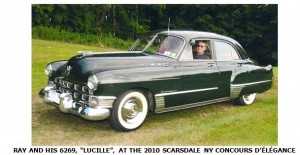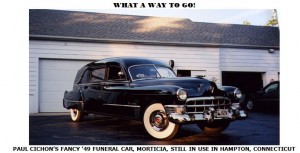Since photos and descriptions of many members’ cars have appeared in the Times over the years, I thought that as my “swan song” I would exercise my prez-idential privileges to show off my own 6107 2-door club coupe, “The Green Queen”. She’s a “late” car, built Oct. 20, 1949 and sold by Rickenbaugh Motors in Denver. (This Cadillac dealer is still in existence and participated in the Grand National in that city in 2001.) In 1974 The Queen went from the original owner to two antique car dealers in Colorado in quick succession, one of whom replaced the original Madeira Maroon paint with a generic dark green. The second dealer sold it in 1975 to a lady in Laramie, Wyoming who, 2 years later, sold it to a collector in the Chicago area. I bought it from him via an ad in Hemmings in Sept. 1984 for $5,200. (‘49s were cheaper in those good old days.) It had been undercoated when new, so was practically rust-free and, though it ran well, was a bit worn cosmetically and mechanically.
I had the motor rebuilt in 1985 and had it re-painted in 1986 another dark green (close to Dartmouth Green, a ’49 color). The next year I had the original worn-out Series 61 upholstery replaced. In 1988, The Queen appeared in the opening scenes of the film “Driving Miss Daisy”, filmed in our Atlanta neighborhood. It played the role of the car of the character Boolie, Miss Daisy’s son, who was played by Dan Akroyd. In one scene Mr. Akroyd drove the car, with Morgan Freeman, who played the character Hoke, as his passenger. If there was such a thing, it surely would have received an Academy Award as “Best Car”.
Originally equipped with Hydra-matic, shortly after I bought the Queen I had stick shift installed with a correct 3.77 ratio differential for that transmission. As she’ll cruise at interstate speeds like a ’49 should, I drive her quite a bit, including 13 trips to CLC Grand Nationals and 3 National Driving Tours as far away from my Georgia home as Maine and Texas. I took the photo below at the ’08 CLC Grand National in New Jersey, following which my wife Elaine and I drove to Manhattan where we left her in a lock-up garage on 42nd Street and then went out “on the town”.
The Queen is in excellent “driver” condition and totally stock except for a cheap Radio Shack under-dash AM/FM radio which plays through the original rear speaker. The vacuum antenna works (when it is in the mood) via a valve from an early ‘40s Cadillac that I hooked up. To enhance the look of the interior (in my humble opinion), I bought from chapter member Dennis Akerman a NOS “standard” steering wheel which is brown in color and of simple construction, unlike the fancy deluxe ivory-colored or black wheels found on most ‘49s. Dennis also sold me a NOS radio delete plate which hides the dash holes where the original radio mounted. Installing goodies like these, along with routine maintenance and occasional major repairs, is enough to keep me busy in retirement. I do much of the work in my garage-workshop, but occasionally need the help of my friends John Wright, a professional restorer, and Times editor Art Gardner for tasks requiring greater skills than my own
Monthly Archives: December 2010
A BETTER WAY TO REMOVE YOUR STEERING WHEEL
by Art Gardner
If, like lots of us, you don’t have a steering wheel puller, I’ve come up with another, if not better, way to remove your steering wheel. Besides doing away with the need for a puller, this method spares the horn button contact from possible damage.
Refer to the drawing below, which shows the top of the steering wheel after the horn button is removed. First, remove the large nut which holds the wheel. Using a small diameter round file (no, not the trash can), file “half-moon” slots into the middle of two opposite sides of the nut to line up with the threaded holes in the hub of the steering wheel.
Now, refer to the drawing on the next page. Go to a hardware store or other supplier of fasteners which sells 3/8-16 “washer-head” bolts, sometimes referred to as washer-head screws. (These are bolts or screws with an integral built-in washer as part of the bolt head.) I suggest that you buy 6 such bolts: 3 pairs or 2 each, in lengths of ¾ inch, 7/8 inch and 1 inch (1.9, 2.2 and 2.5 cm.), if available. You can see two of them in the drawing.
As shown in the drawing below, loosely screw on the large steering wheel hold-down nut the until most or all of its threads have engaged the steering shaft, but with some space still remaining between the bottom of the nut and the steering wheel hub. At the same time, make sure the two “half-moon” slots are lined up with the threaded holes in the steering wheel hub. Then, starting with the 1 inch pair, screw two of the washer-head bolts past the “half-moon” slots and into the threaded holes in the steering wheel hub until the washer heads are snug against the large steering wheel nut.
Now, using a wrench, slowly and carefully tighten the washer-head bolts, each one a fraction of a turn at a time, so that neither bolt puts more pressure on the nut than the other. Advantageously, this works by putting force on the large threads of the steering column shaft, instead of on the end of the shaft (where it could damage the horn contact).
As I did, you may find that you will have to exchange the first pair of washer-head bolts for a shorter pair as the steering wheel is pulled up. You may also find that you’ll have to unscrew the large steering wheel nut one or more turns to create more space between it and the steering wheel hub. When the steering wheel breaks loose, you may or may not hear a snapping or popping noise. Like the 3 guys lowering the engine in the factory photo on page 3, “Easy does it”
MORE ON HOOKING UP HEATER HOSES
Chapter member Daniel Parker of Palmdale, California sent in the diagram below and wrote that he thought it “might help the next time someone asks how to route heater hoses”. To aid in using Daniel’s diagram, members may want to refer to the June ’09 issue of the Times, in which there appeared an article describing in text the routing of these hoses.
AN INTERESTING FORTY-NINE FACTORY PHOTO
This factory photo, probably taken at Cadillac’s Clark Street plant in Detroit, shows 3 workers lowering a ’49 overhead valve engine into a car’s chassis. After studying the picture a bit, there are several interesting factoids that can be gleaned from it.
Art Gardner points out that the installation does not appear to be taking place on an assembly line; it looks more like a small side room since there are non-Cadillac cars in the background (of which the first is a Chevrolet or Pontiac station wagon while behind it appears to be a ’46 or ’47 Buick). Obviously, the three men are posing for the photographer. The guys doing the work seem to be the two men at the left and right, as they are wearing shop clothes and have their hands on the chain hoist and engine as they maneuver it into position. The guy in the middle must be a supervisor, as he has on a white shirt and seems to be motioning the guy on the left working the hoist to lower the engine v e r y s l o w l y and carefully so it won’t bang into anything. The job of the guy at the right must be to push and pull on the motor to doubly make sure of just that, as well as to ensure that the downward facing motor mount bolts go straight into their holes on the frame.
It’s an early 1949 Cadillac engine, as there are 2 bolts at the top holding on the valve cover instead of the 4 bolts around the perimeter of the valve cover used later in the year. Also, the spark plug wires are enclosed in a flat enclosed conduit bolted to the valve cover, rather than the open metal loops used later in the year. In addition, compare the color of the paint on the letters and 3 lines at the forward end of the valve cover to the supervisor’s shirt: it is somewhat darker. This leads me to believe the paint on the valve cover lettering is the silvery gray used on very early cars rather than the white paint used the rest of the year.
Looking at the chassis, several tidbits of info emerge. The first is that there is a ’48 horn ring on the steering wheel, a further indication that this is a very early ’49 Cadillac. The ’48 and ’49 steering wheels are the same, but the ’48 horn ring is a 180 degree half-circle around the lower half of the wheel like the horn ring in the photo, while the ’49 horn ring is a 360 degree full circle. The next thing you’ll notice is that under the left elbow of the man at the right is a clutch pedal. Also, you can just make out under his left hand that there are two shift levers coming out of the steering column rather than the single lever used with Hydra-matic, so this car has a manual transmission. This is noteworthy in that less than 4% of ’49s were so built.
Art thinks that “perhaps this was a test engine that was run on a test stand for a while and then installed in a 48 chassis for some final testing before production began for 49. For example, the exhaust manifolds look “seasoned”, meaning the engine is not completely new. All this may mean that the photo was taken sometime in 1948.
HAVING A BALL WITH LUCILLE
Lucille came into my life at a good time. I was feeling aimless and a bit down and she gave me a reason to get my thoughts together and gather up my tools. I don’t know why I named her Lucille; it just felt right. Someone I know suggested I call her Greta. He said it felt right; well, maybe for him. Let me tell you a bit about this beauty so you’ll understand how I got hooked.
I’ve admired the designs of Harley Earl since I was a kid. For the last 60 years, however, I didn’t know his name, just his sense of design. I narrowed down that I wanted a Harley Earl designed car and more specifically, a Cadillac. I narrowed down the years to about 1948 or 1949. The design and mechanics of those years to me were special to me. I chose 1949 since that was the year that the new V8 engine replaced the old flathead design. It introduced greater efficiency and horsepower while reducing the weight and size of the engine.
I Googled “1949 Cadillac” and one of the available choices mentioned that it was in Scarsdale, New York, a Westchester County suburb of New York City not far from my home in Patterson, NY. When the picture opened, I saw this beautiful dark green Cadillac parked on the streets of Scarsdale. The shape, design, color of the Series 62, 4 door sedan all but swept me off my feet. Oddly enough, it had a special New York license plate that said ‘HYDRMTIC’. I found that unusual. Why would anyone advertise that their car had an automatic transmission? To each his own. As days passed, I returned to that page repeatedly. I found that the car had been one of those participating in the Scarsdale Concours d’Elégance back in 2005. Well, we all have dreams and this was mine.
As I got more serious about actually buying an old car, I saw an ad in Hemmings Motor News offering a 1949 Caddy in that same nearby Westchester County. Well, that was close enough to be able to check out a car before buying. Previously, I had put in a winning bid on Ebay for a 1949 Caddy in Maine. The reserve was not met and I didn’t get that car, although the seller later contacted me about making a deal. As we exchanged emails, more and more faults of the car came out and I backed away from any deal. Now, looking back at that car, I was lucky not to get it.
I contacted the seller of my Hemmings’ Westchester County car who answered many questions and agreed to send pictures. When I opened the pictures on my computer, I saw that the car’s license plate read, “HYDRMTIC”. Wow! I had stumbled across my dream car. Fortunately, the price was excellent and I just agreed to it. The seller was a financial advisor with an impressive large, old home. He had bought this car 10 years ago at an auction at Lyndhurst Castle in Irvington, NY conducted by Christie’s Auction House. He showed me the published Christie’s booklet showing all the cars entered in this auction, including this beauty. Wow, this car was being sold with other fantastic cars whose values were estimated up to $750,000 by Christie’s. While this car’s value was a mere fraction of the value of the others, I felt it was sitting in good company.
The seller said that his interest in the car had slowly diminished and he wanted something newer. He provided great paperwork with the car, including the actual California license plate on the car when he got it, a copy of the owners’ manual, shop manual, original ‘build sheet’, data sheet, accessories brochure, loads of General Motors paper and some spare parts for the car. Time to clear out the garage!
I wound up completing the purchase and received the Christie’s booklet and the actual auction paddle used by the seller ten years ago. He also supplied ten years of receipts for repairs and purchases for this car. From the information on the paperwork, it was easy to see that he had put about 2,000 miles on the car in ten years (that’s an average of only 4 miles per week!). The car’s finish isn’t perfect and it needs some mechanical attention; however, I’m in love with Lucille and hope to show it off when gathering with my fellow members of the Cadillac-LaSalle and Lambda Car Clubs.
ALL GOOD THINGS
finally come to an end, they say. Yes, I’m sad to say, this will be the last issue of the ’49 Times I’ll be putting together, as I’ve finally reached a point where I’d like to completely retire. This issue will be the 40th issue of the Times to appear since 2001, during which time we all have had a forum to say quite a bit about our favorite car. Is there more to say about ‘49s? Certainly, but it will have to be with a new Prez.
If any current chapter member(s), or anyone else, would like to take over and put out the Times, I would be very pleased to assist and get things going, as well as to contribute the occasional article. The mailing list, which includes details of each member’s car(s) and his/her dues status, is in a simple ancient software package which can be mastered in a minute. Getting out the newsletter requires 3-4 hours of scanning and word processing work once every 3 months. I then run the result by Editor Art Gardner. You’d then get it to your favorite print shop (though the current print shop could also be used) and several days later collect the finished folded and stapled copies. My wife and I then spend about an hour sticking stamps and address labels on them, after which I carry them to the post office. It’s actually fun and you’ll get to know many other ’49 owners, either personally or by phone and email. The only other tasks are to: 1. deal with members’ dues payments and keep the books, most of which occurs from December to March; and, 2. organize a chapter meeting at CLC Grand National Meets if you are so inclined. If interested, contact me by email as above or by snail mail or phone as per my listing in the CLC directory.
An upside of this is that you won’t have me badgering you any more with those annoying post cards to mail in that $8 check! (Surely one of the best bargains since 1949.) If the Times does not continue, those members who are already paid up for 2011 and beyond will receive a refund in the mail. Back issues will still be available at $2.50 postpaid or $2.75 outside the USA.
On a more positive note, I had a great time again this year at the great Hershey flea market and car show October 6-9. Art Gardner couldn’t go but lent me his Chevy Suburban to carry my stuff. Chapter member Joe Cutler and I shared a motel room and spent much more money than we should have buying ’49 stuff we just had to have. Chapter member Jim Murdoch (MA), who now owns a ’50 but used to have a ’49, graciously agreed to display the stuff I had for sale in his vendor’s space, which partially made up for my extravagance. On the evening of the 8th we went to dinner with ‘49er Jon Schneck, who is restoring a convertible, along with his dad and some other friends. Other ‘49ers spotted at the meet included Dennis Akerman, Paul Cichon, Randy Denchfield, Bill Edmunds and Rege McDonough, although numerous others, no doubt, were there too.
On a parting note, I’d like to wish all Forty-Niners a very Merry Christmas or a Happy Chanukah and, for 2011, an especially Happy New Year. May your ’49(s) start quickly, run sweetly and shine brightly in 2011 and thereafter. Meanwhile, I hope you’ll find this last issue as interesting as always
